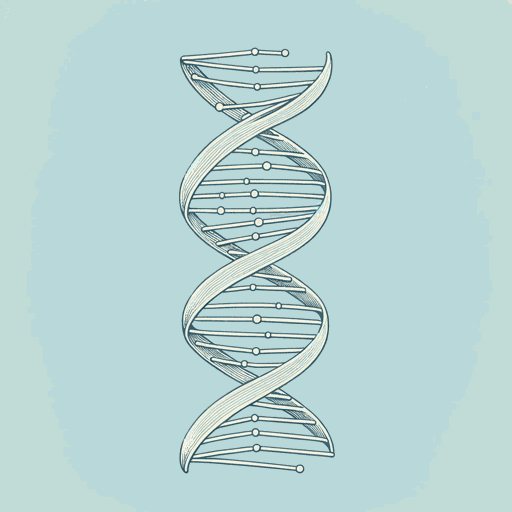84 pages • 2 hours read
James D. WatsonThe Double Helix
Nonfiction | Book | Adult | Published in 1968A modern alternative to SparkNotes and CliffsNotes, SuperSummary offers high-quality Study Guides with detailed chapter summaries and analysis of major themes, characters, and more.
Summary and Study Guide
Overview
The Double Helix is American scientist James Watson’s personal account of the discovery of the structure of DNA. He and Francis Crick succeed in determining the three-dimensional chemical structure of DNA in 1953, while they were working together at Cavendish Laboratory, at Cambridge University. Their discovery is widely acknowledged as one of the most important scientific discoveries of the 20th century and a ground-breaking event for biology, genetics, and our understanding of life itself. This is partly because of what the scientists” model suggests about the way DNA works as genetic code. DNA was already thought to be important in the transference of hereditary information from cell to cell, but Watson and Crick’s structure showed how this worked on a molecular level, indicating the way genes, cells and ultimately all lifeforms reproduce.
Watson’s account traces the journey to this momentous discovery, in both personal and scientific terms, from just before his arrival in Cambridge, in 1951, through the years of collaboration with Crick, up to the validation of their structure in 1953. It also traces the involvement of various other scientists.
While Watson and Crick discovered the correct structure and chemical composition of the DNA molecule—a double helix chain with four nucleotide pairs bonded by hydrogen within the structure—how they came to this position is a complex story, involving the influence and contributions of many other scientists. Notably, they were dependent on the x-ray diffraction work on DNA being conducted by Maurice Wilkins and Rosalind Franklin at Kings College, London. They were also largely influenced, and spurred on, by the work of renowned American chemist Linus Pauling.
While The Double Helix was published in 1968, the account is told from the perspective of Watson in the early 1950s. It is constructed from letters and memories, and reflects his immediate impressions at the time, some of which have proven controversial. One of Watson’s main stated aims in the book is to show the human side of how science develops; thus, in the narrative, we see repeatedly how science and personal factors intersect, and we are presented with a shifting of focus between treatment of DNA and discussion of the scientists” social lives in Cambridge.
The narrative begins with descriptions of the group working in the Cavendish lab prior to Watson’s arrival, and the important scientific work on DNA by Wilkins and Franklin. Watson, then a post-doctoral research fellow in Copenhagen, describes his own growing interest in DNA, and a meeting with Wilkins which led him to seek out a way of pursuing the problem at the Cavendish, though officially he is there to work on protein molecules.
The relationship with Crick is established, and they set about working on DNA unofficially, mostly in the hours over lunch. We hear about Pauling’s work postulating an a-helix structure within protein molecules, using three dimensional models, and Watson and Crick start applying this approach to DNA.
Crick refines a theory that helps detect helices in x-ray photographs, and Watson attends a talk by Franklin to gather new data. On the back of this they hit upon a model which they think is close to a solution: a three-chained helix. Wilkins and Franklin are brought to see, but are thoroughly unconvinced. Franklin in particular has no interest in helices or model building, preferring to rely on x-ray evidence. Kings College has priority in the work on DNA, and Crick and Franklin are told to leave the project aside.
They focus their efforts on other things, but DNA is always somewhere in the background. The turning point comes when they get hold of a draft of a paper from Pauling on DNA, which looks to have cracked it, but in fact proves to be mistaken. This gives renewed impetus to their work.
Watson goes to London to show the paper to Wilkins and has an argument with Franklin. Wilkins, whose relationship with Franklin has been very strained for some time, is sympathetic and shows him a crucial x-ray photograph that suggests a helical structure.
With these fresh details, Watson and Crick begin a new assault on the problem and, after one further false start, the foundation of the final solution is established. It hinges on the way irregular nucleotide pairs bond together to fit into the regular helical chains of the DNA molecule. They realise that their structure based on complimentary chains has huge implications for the way genes reproduce.
Quickly the solution is finalised and tested, with various Cambridge scientists helping out. Wilkins and Franklin are told of the success and the four simultaneously publish papers on their findings.
Despite its scientific content, The Double Helix was written for a general reader and is fairly accessible. That said, a basic grasp of the science involved and the terminology used in relation to DNA will greatly aid both understanding and enjoyment of Watson’s account. It is certainly useful to build a clear mental picture of the DNA molecule, its component parts, and its implications for gene replication.

